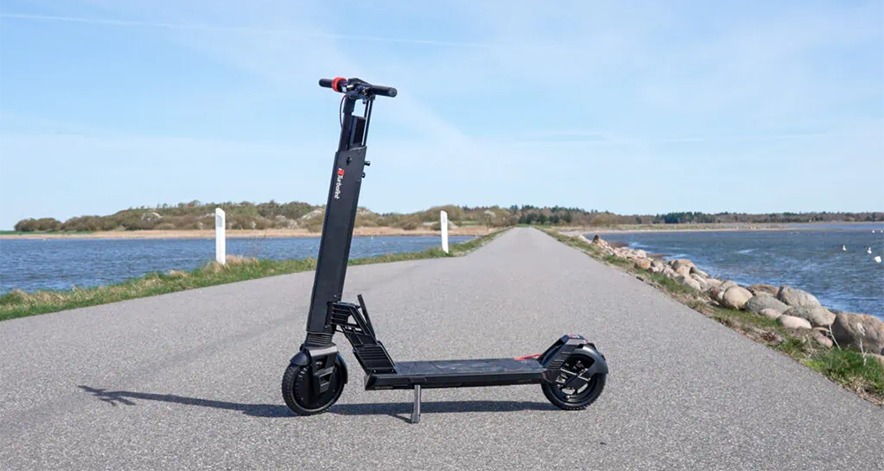Electric scooters have rapidly surged in popularity as an eco-friendly and convenient mode of urban transportation. With the rise in usage, the importance of understanding and selecting the right tires for electric scooters has become paramount. One of the significant debates in this realm centers on the choice between pneumatic and solid tires—two distinct options each bearing its own set of advantages and disadvantages
Electric scooter tires, the sole point of contact between your scooter and the road, play a pivotal role in determining the overall riding experience. They affect how your scooter handles different terrains, absorbs shocks, and maintains traction, making them a crucial element in ensuring a safe and enjoyable ride
When it comes to choosing between pneumatic and solid tires for your electric scooter, there's no one-size-fits-all answer. The optimal tire type varies based on a multitude of factors, such as your riding environment, frequency of use, desired comfort level, maintenance preferences, and budget constraints
Ultimately, your decision should align with your individual preferences and requirements to ensure a seamless and enjoyable riding experience.

Part 1. Two Types of Electric Scooter Tires
A. Pneumatic Tires
Pneumatic tires, as the name suggests, are designed with an internal chamber that contains air, giving them a cushioning effect and the ability to absorb shocks and vibrations. They are constructed with an inner tube that holds the air and an outer rubber layer that provides traction and durability. The air-filled design allows these tires to absorb shocks and provide a smoother ride by cushioning the impact of bumps and uneven surfaces on the road.
There are two subtypes of Pneumatic Tires:
1. Tubeless Tires:
Tubeless pneumatic tires are becoming increasingly popular in the world of electric scooters. These tires eliminate the need for an inner tube, relying on a special lining within the tire to maintain air pressure. It's a suitable choice for riders seeking a versatile and low-maintenance option.
2. Tires with Tubes:
Tires with tubes, like those found on the TurboAnt M10 Lite, and the TurboAnt X7 Max, boasting a powerful 350W brushless motor and a range of up to 32 miles, features 10-inch tubeless pneumatic tires. This design not only reduces the risk of punctures but also makes for easier maintenance.

TurboAnt M10 Lite comes with a separate inner tube that holds the air. The M10 Lite, equipped with a 350W brushless motor, offers a maximum range of 15.5 miles and a top speed of 16 mph. Its 8.5-inch pneumatic tires provide a comfortable ride on various surfaces. Additionally, this model features a 3-second quick folding mechanism, a USB charging port, and a dual braking system with disc and electronic brakes, enhancing both safety and convenience.

B. Solid Tires
Solid tires are a popular choice for electric scooters due to their durability and low maintenance. Unlike pneumatic tires, solid tires do not contain an inner tube filled with air. Instead, they are made of solid, dense material that is puncture-proof, providing a hassle-free riding experience. The composition of solid tires typically includes a mix of rubber, plastic, and other polymers, ensuring a long-lasting and resilient tire surface.
These tires are designed to offer resistance to wear and tear, making them a practical option for those seeking longevity and minimal upkeep.
They are classified under three types:
1. Fully Solid Tires:
Fully-solid tires are made entirely of a dense rubber or rubber-like material, ensuring they are entirely puncture-proof and maintenance-free. These tires provide a smooth and consistent ride, ideal for city commuting.
2. Honeycomb Solid Tires:
Honeycomb solid tires feature a unique hexagonal honeycomb structure within the tire. This design offers a balance between comfort and durability, providing a relatively smoother ride compared to fully-solid tires. The honeycomb structure allows for some shock absorption while maintaining puncture resistance.
The TurboAnt V8 E-Scooter has two tire options including 9.3-inch pneumatic tires and 9.5-inch honeycomb tires, featuring a powerful 450W brushless motor and dual 7.5Ah batteries. With a maximum range of 50 miles and a top speed of 20 mph, this scooter offers a comfortable and dependable ride for urban travelers.

3. Foam-Filled Tires:
Foam-filled tires are solid tires that are injected with foam to mimic the cushioning effect of air-filled tires. While not as soft as pneumatic tires, foam-filled solid tires offer a compromise between comfort and maintenance. They can handle varying terrains while still being resistant to punctures.
Part 2. The Comparison Between Pneumatic and Solid Tires
Electric Scooter Pneumatic Tires
A. Characteristics and Benefits
- Smooth Ride Quality: Pneumatic tires provide a smoother and more comfortable ride due to their ability to absorb shocks and vibrations. The air-filled design acts as a cushion, minimizing the impact of uneven surfaces and potholes on the rider.
- Off-road Capabilities: Pneumatic tires are versatile and can handle a variety of terrains, including uneven or off-road surfaces. They provide superior traction and stability, making them suitable for riders who venture beyond city streets.
- Durability: Well-maintained pneumatic tires can last a long time, providing a reliable and robust solution for regular commuting. The durability is a result of the tire's construction and the materials used in its manufacturing.
- Ease of Exchange: In case of damage or wear, replacing pneumatic tires is relatively easy and cost-effective. Most electric scooter owners can change a pneumatic tire with minimal tools and expertise.
- Versatility: Pneumatic tires are available in various sizes and tread patterns, allowing riders to tailor their scooters for specific uses and preferences. This versatility ensures riders can find the right balance between speed, range, and terrain adaptability.
B. Disadvantages
- Proneness to Punctures: Pneumatic tires are susceptible to punctures, which can be caused by sharp objects on the road. This vulnerability requires riders to remain vigilant and often necessitates timely repairs or replacements.
- Higher Cost: Initially, electric scooters with pneumatic tires may have a higher upfront cost compared to those with solid tires. Additionally, the potential for punctures can incur extra costs for repairs or replacements.
- Difficulty in Determining the Right Pressure: Maintaining the correct tire pressure is crucial for optimal performance and safety. However, determining the right pressure can be challenging for some riders.
- Regular Maintenance Routines: Pneumatic tires require regular maintenance, including checking and adjusting tire pressure, patching punctures, and occasionally replacing tubes or tires.
- Impact of Temperature Fluctuations on Handling: Extreme temperature changes can affect tire pressure, potentially influencing the scooter's handling and stability.
Electric Scooter Solid Tires
A. Characteristics and Benefits
- Flat Immunity: Solid tires are puncture-proof, offering immunity against flats caused by sharp objects or debris on the road. This feature ensures uninterrupted rides and eliminates the need for tire repairs or replacements due to punctures.
- Safety: With no risk of sudden deflation, solid tires contribute to a safer riding experience. Riders can confidently navigate through urban environments without worrying about tire-related accidents or loss of control.
- Cost-Effectiveness: Over the long run, solid tires can prove to be cost-effective due to their resistance to punctures and low maintenance requirements. The absence of repair costs and the need for regular replacements contribute to cost savings for the rider.
- Low Maintenance: Solid tires require minimal maintenance compared to their pneumatic counterparts. Riders don't need to monitor tire pressure, check for punctures, or replace inner tubes, streamlining maintenance routines.
- Stability in Temperature Fluctuations: Solid tires maintain a consistent level of stability and performance regardless of temperature fluctuations. Unlike pneumatic tires, they are not affected by changes in air pressure due to varying weather conditions.
B. Disadvantages
- Lack of Longevity: Solid tires may have a shorter lifespan compared to pneumatic tires, particularly when subjected to rough or uneven terrains. Their rigid composition can lead to quicker wear and tear over time.
- Limited Versatility: Solid tires are generally best suited for urban commuting and well-paved surfaces. They may lack the versatility to handle off-road or uneven terrains with the same level of comfort and traction that pneumatic tires offer.
- Weight: Solid tires are typically heavier than pneumatic tires due to their solid construction. This additional weight can impact the scooter's overall performance and handling, especially during acceleration and maneuvering.
- Poor Ride Quality: The lack of air cushioning in solid tires results in a stiffer ride compared to the smoother, more comfortable ride offered by pneumatic tires. Riders may experience more vibrations and a less cushioned feel, especially on bumpy surfaces.
The choice between electric scooter pneumatic and solid tires involves considering a range of factors. Pneumatic tires offer a smoother ride, versatility, and durability but are vulnerable to punctures. In contrast, solid tires provide flat immunity, safety, and cost-effectiveness, although they can compromise ride quality.
We recommend riders carefully assess their unique needs and preferences when making their tire selection. Evaluate your daily routes, terrain conditions, and willingness for maintenance to ensure you choose a tire type that aligns with your riding style.























